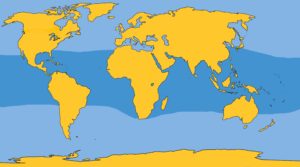Family: Delphinidae
Genus: Lagenodelphis
Species: L. hosei Fraser, 1956
This species was originally described on the basis of a single skeleton obtained by a Mr. E. Hose from a western Borneo beach in 1895. It was not described from life until 1971, when several of the animals were caught in tuna nets in the eastern tropical Pacific Ocean. Also, in 1971, another group of Fraser’s dolphins was captured in the Philippines and transported to an oceanarium in Hong Kong where they lived only a short time. Reports of the behavior of Fraser’s dolphins are sketchy. For the most part, they are very wary of ships and swim rapidly away when approached, which may very well account for their relative obscurity. They are sighted relatively frequently in the eastern tropical Pacific Ocean because of extensive cetacean research in that area.
Physical Description: This is a stocky animal with a short but well-defined beak.
Color: Gray dorsally, white ventrally, with gray flippers. A thick dark stripe appears on most animals below a cream-colored stripe, both extending along the lower flanks from the rostrum to the anus. The dark gray sides of the lower jaw lighten gradually toward the flippers.
Fins and Flukes: A tiny, dark gray, falcate dorsal fin is located on the mid-back region. The tiny flippers are thin and curve to points. The small, well-developed flukes are pointed or slightly rounded at their tips, with a small median notch.
Length and Weight: These animals reach at least 8 ft (2.4m) and an estimated weight of 140 to 180 lbs (64 to 82 kg).
Teeth: Each side of the upper jaw contains 40 to 44 small, conical teeth, while the lower jaw has 39 to 44 per side.
Feeding: Stomach contents contained deep-sea fish, squid, and crustaceans.
Breathing and Diving: No information is available, mostly because these animals are rarely observed without the presence of a vessel, from which they flee rapidly.
Mating and Breeding: There is no information available.
Herding: They herd in large numbers, often more than 500. In the eastern tropical Pacific Ocean they often swim in close proximity to spinner and spotted dolphins, striped dolphins, false killer whales, and sperm whales.
Distribution: They are known to inhabit the eastern tropical Pacific, the Indo-Pacific region, and recent reports put them in the tropical Atlantic. Strandings have occurred in Australia, South Africa, Japan, and the Philippines.
Migration: No information is available.
FRASER’S DOLPHIN DISTRIBUTION








